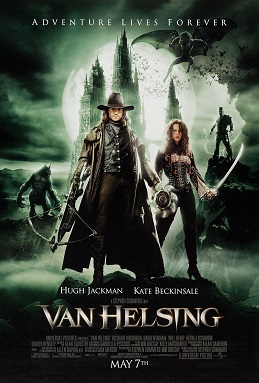
Van Helsing is a 2004 action horror film written and directed by Stephen Sommers. It stars Hugh Jackman as monster hunter Van Helsing and Kate Beckinsale as Anna Valerious. Van Helsing is both an homage and tribute to the Universal Horror Monster films from the 1930s and 1940s, of which Sommers is a fan.
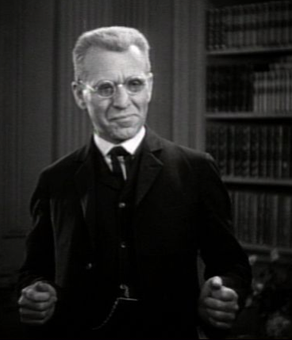
Professor Abraham Van Helsing is a fictional character from the 1897 gothic horror novel Dracula written by Bram Stoker. Van Helsing is a Dutch polymath doctor with a wide range of interests and accomplishments, partly attested by the string of letters that follows his name: "MD, D.Ph., D.Litt., etc.", indicating a wealth of experience, education and expertise. He is a doctor, professor, lawyer, philosopher, scientist, and metaphysician. The character is best known through many adaptations of the story as a vampire slayer, monster hunter and the arch-nemesis of Count Dracula, and the prototypical and the archetypical parapsychologist in subsequent works of paranormal fiction. Some later works tell new stories about Van Helsing, while others, such as Dracula (2020) and I Woke Up a Vampire (2023) have characters that are his descendants.
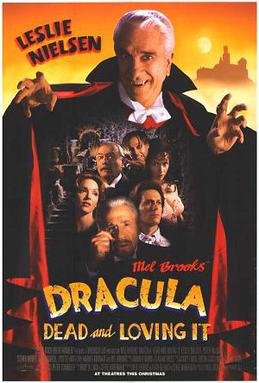
Dracula: Dead and Loving It is a 1995 comedy horror film directed by Mel Brooks and starring Leslie Nielsen. It is a spoof of Bram Stoker's novel Dracula and of some of the story's well-known adaptations.

Dracula is a 1958 British gothic horror film directed by Terence Fisher and written by Jimmy Sangster based on Bram Stoker's 1897 novel of the same name. The first in the series of Hammer Horror films starring Christopher Lee as Count Dracula, the film also features Peter Cushing as Doctor Van Helsing, along with Michael Gough, Melissa Stribling, Carol Marsh, and John Van Eyssen. In the United States, the film was retitled Horror of Dracula to avoid confusion with the U.S. original by Universal Pictures, 1931's Dracula.
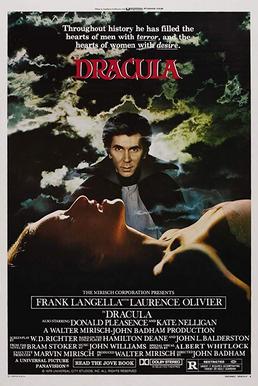
Dracula is a 1979 gothic horror film directed by John Badham. The film starred Frank Langella in the title role as well as Laurence Olivier, Donald Pleasence and Kate Nelligan.

Wilhelmina "Mina" Harker is a fictional character and the main female character in Bram Stoker's 1897 Gothic horror novel Dracula.

The Brides of Dracula is a 1960 British supernatural gothic horror film produced by Hammer Film Productions. Directed by Terence Fisher, the film stars Peter Cushing, David Peel, Freda Jackson, Yvonne Monlaur, Andrée Melly, and Martita Hunt. The film is a sequel to the 1958 film Dracula, though the character of Count Dracula does not appear in the film, and is instead mentioned only twice. Christopher Lee would reprise his role as Dracula in the next film in the Dracula series, Dracula: Prince of Darkness (1966).

Dracula 3000 is a 2004 made-for-television science fiction horror film directed by Darrell Roodt. An international co-production of the United States and South Africa, the film's plot follows the vampire Count Dracula, in the futuristic setting of outer space in the 30th century. Despite its title, the film is not a sequel to Dracula 2000.

The Satanic Rites of Dracula is a 1973 British horror film directed by Alan Gibson and produced by Hammer Film Productions. It is the eighth film in Hammer's Dracula series, and the seventh and final one to feature Christopher Lee as Dracula. The film was also the third to unite Peter Cushing as Van Helsing with Lee, following Dracula (1958) and Dracula A.D. 1972 (1972).

Lucy Westenra is a fictional character in the 1897 novel Dracula by Bram Stoker. The 19-year-old daughter of a wealthy family, she is Mina Murray's best friend. Early in the story, Lucy gets proposed to by three suitors, Arthur Holmwood, John Seward, and Quincey Morris, on the same day. Turning the latter two down due to already being in love with Arthur, she accepts his proposal. Before getting the chance to marry, Lucy becomes Count Dracula's first English victim, and despite Seward contacting Abraham Van Helsing for help, she transforms into a vampire. Following her return as a vampire and attacks on children—dubbed the "Bloofer Lady" by them—she is eventually cornered into her crypt by Van Helsing and her suitors who destroy her, putting her soul to rest.

Dracula, the Musical is a musical based on the original 1897 Victorian novel by Bram Stoker. The score is by Frank Wildhorn, with lyrics and book by Don Black and Christopher Hampton.
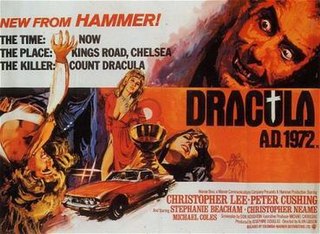
Dracula A.D. 1972 is a 1972 British horror film, directed by Alan Gibson and produced by Hammer Film Productions. It was written by Don Houghton and stars Christopher Lee, Peter Cushing and Stephanie Beacham. Unlike earlier films in Hammer's Dracula series, Dracula A.D. 1972 had a contemporary setting in an attempt to update the Dracula story for modern audiences. Dracula is brought back to life in modern London and preys on a group of young partygoers that includes the descendant of his nemesis, Van Helsing.

Count Dracula is a British television adaptation of the 1897 novel Dracula by Bram Stoker. Produced by the BBC, it first aired on BBC 2 on 22 December 1977. It is among the more faithful of the many adaptations of the original book. Directed by Philip Saville from a screenplay by Gerald Savory, it stars Louis Jourdan as Count Dracula and Frank Finlay as Professor Van Helsing.

Dracula, also known as Bram Stoker's Dracula and Dan Curtis' Dracula, is a 1974 British made-for-television gothic horror film and adaptation of Bram Stoker's 1897 novel Dracula. It was written by Richard Matheson and directed by Dark Shadows creator Dan Curtis, with Jack Palance in the title role. It was the second collaboration for Curtis and Palance after the 1968 TV film The Strange Case of Dr. Jekyll and Mr. Hyde.

Dracula II: Ascension is a 2003 direct-to-video American-Romanian vampire film, directed by Patrick Lussier. It stars Jason Scott Lee, Stephen Billington and Diane Neal. Filmed entirely in Romania by Castel Film Studios, the film is the sequel to Dracula 2000. It was released direct-to-video on June 7, 2003.

Dracula III: Legacy is a 2005 vampire film and the sequel to Dracula 2000 and Dracula II: Ascension. The film was directed by Patrick Lussier and stars Jason Scott Lee, Jason London, Roy Scheider, and Diane Neal. It was released direct-to-video on July 12, 2005.

Bram Stoker's Dracula's Curse is a 2006 horror film by The Asylum, written and directed by Leigh Scott. Despite featuring Bram Stoker's name in the title, the film is not directly based on any of his writings or a mockbuster to the 1992 film Bram Stoker's Dracula, but shares similarities to films such as Blade: Trinity, Dracula 2000, Underworld: Evolution and Van Helsing. The film also shares some similarities with the 1971 Hammer horror film Countess Dracula, which also features a Dracula-esque femme fatale in the lead role.
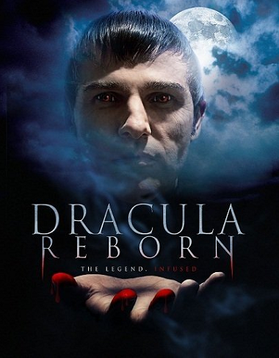
Dracula Reborn is a 2012 vampire-themed direct-to-video horror film, directed and written by Patrick McManus, making his feature film directorial debut. Produced by Ray Haboush, the film stars Corey Landis, Victoria Summer, Krash Miller, Stuart Rigby and Keith Reay. It is a modernized, loosely based take on Bram Stoker's 1897 novel Dracula, taking place in Los Angeles, California, where a wealthy Count Dracula looks to purchase an abandoned building and pursue the wife of his realtor, Jonathan Harker.
Dracula is a British horror film series produced by Hammer Film Productions. The films are centered on Count Dracula, bringing with him a plague of vampirism, and the ensuing efforts of the heroic Van Helsing family to stop him. The original series of films consisted of nine installments, which starred iconic horror actors Christopher Lee and Peter Cushing as Count Dracula and Doctor Van Helsing, respectively. The series is part of the larger Hammer horror oeuvre.
Hrabě Drakula is a Czechoslovakian 1971 black and white TV film adaptation of Bram Stoker's original novel Dracula.


















